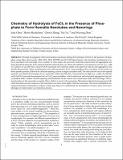Files in this item
Chemistry of hydrolysis of FeCl3 in the presence of phosphate to form hematite nanotubes and nanorings
Item metadata
| dc.contributor.author | Chen, Jialu | |
| dc.contributor.author | Macfarlane, Shona | |
| dc.contributor.author | Zhang, Chenxi | |
| dc.contributor.author | Yu, Kai | |
| dc.contributor.author | Zhou, Wuzong | |
| dc.date.accessioned | 2018-09-26T23:45:58Z | |
| dc.date.available | 2018-09-26T23:45:58Z | |
| dc.date.issued | 2017 | |
| dc.identifier | 251300934 | |
| dc.identifier | 88fdd8a3-b577-4615-ab3b-32f4bb1d06f8 | |
| dc.identifier | 85032660217 | |
| dc.identifier | 000414506300044 | |
| dc.identifier.citation | Chen , J , Macfarlane , S , Zhang , C , Yu , K & Zhou , W 2017 , ' Chemistry of hydrolysis of FeCl 3 in the presence of phosphate to form hematite nanotubes and nanorings ' , Crystal Growth & Design , vol. 17 , no. 11 , pp. 5975-5983 . https://doi.org/10.1021/acs.cgd.7b01083 | en |
| dc.identifier.issn | 1528-7483 | |
| dc.identifier.other | ORCID: /0000-0001-9752-7076/work/58054990 | |
| dc.identifier.uri | https://hdl.handle.net/10023/16086 | |
| dc.description | JC thanks joint scholarship from Chinese Ministry of Education (CSC grant) and University of St Andrews. The authors thank the EPSRC for financial support on FEG-SEM equipment (EP/F019580/1) and Titan Themis S/TEM microscope (EP/L017008/01). | en |
| dc.description.abstract | Through investigation of the intermediate specimens during the hydrolysis of FeCl3 in the presence of phosphate using Mass spectroscopy, XRD, EDX, SEM, HRTEM and ICP-OES Spectrometry, the formation mechanisms of α-Fe2O3 nanotubes and nanorings were revealed. At early stages, the precursor molecules polymerized and aggregated into large disordered particles, from which β-FeOOH nanorods grew up. When the NaH2PO4 concentration was low (e.g. 1 mM in a solution of 23 mM FeCl3), the β-FeOOH nanorods were relatively stable and underwent side-by-side aggregation into spindle-like particles. Phase transformation into self-orientated α-Fe2O3 nanocrystallites then took place on the surface of these spindle particles, followed by Ostwald ripening, to form a single-crystalline shell. The ends and the core of the spindle particles were dissolved, forming α-Fe2O3 nanotubes. When the NaH2PO4 concentration was high (e.g. 4 mM), the individual β-FeOOH nanorods decomposed into α-Fe2O3 nanocrystallites, which underwent self-orientated aggregation into polycrystalline disks. Surface Ostwald ripening and dissolution of the central area turned these disks into nanorings. The exposed surface in the nanotubes is mainly (hk0), while it is (001) in the nanorings. Photoelectrochemical measurement indicated that photocurrent response of the nanotubes was three times higher than the nanorings. This newly established non-classical formation mechanisms of these crystals may help us to understand the development of many other novel morphologies of metal oxides via a hydrolysis process. | |
| dc.format.extent | 5075587 | |
| dc.language.iso | eng | |
| dc.relation.ispartof | Crystal Growth & Design | en |
| dc.subject | QD Chemistry | en |
| dc.subject | NDAS | en |
| dc.subject.lcc | QD | en |
| dc.title | Chemistry of hydrolysis of FeCl3 in the presence of phosphate to form hematite nanotubes and nanorings | en |
| dc.type | Journal article | en |
| dc.contributor.sponsor | EPSRC | en |
| dc.contributor.sponsor | EPSRC | en |
| dc.contributor.institution | University of St Andrews. School of Chemistry | en |
| dc.contributor.institution | University of St Andrews. EaSTCHEM | en |
| dc.identifier.doi | https://doi.org/10.1021/acs.cgd.7b01083 | |
| dc.description.status | Peer reviewed | en |
| dc.date.embargoedUntil | 2018-09-27 | |
| dc.identifier.grantnumber | EP/F019580/1 | en |
| dc.identifier.grantnumber | ep/l017008/1 | en |
This item appears in the following Collection(s)
Items in the St Andrews Research Repository are protected by copyright, with all rights reserved, unless otherwise indicated.

